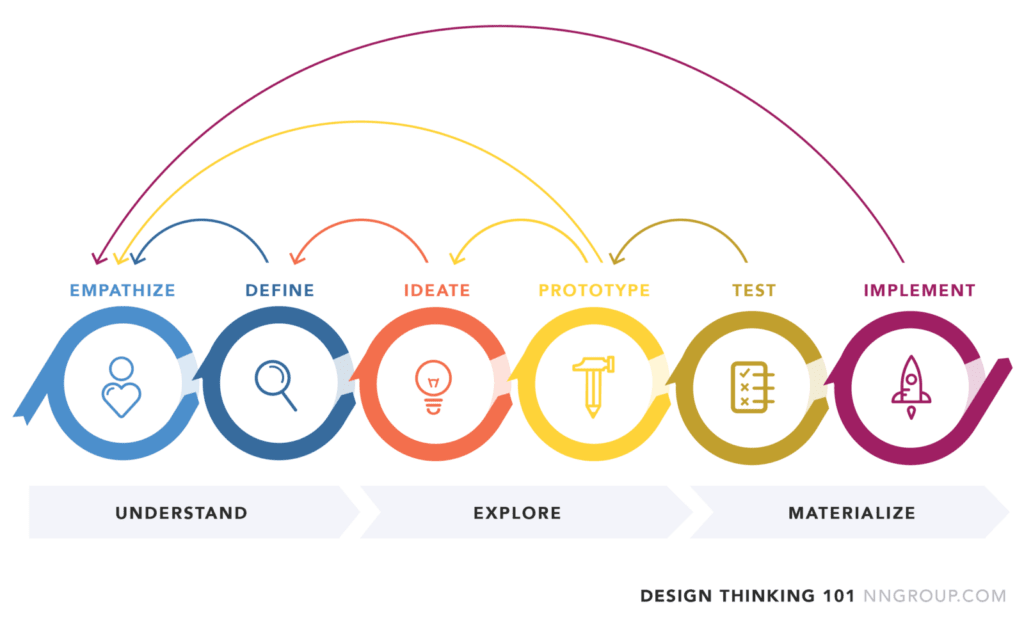Design thinking strategy is having an impact on businesses everywhere. Here’s how.
What are the benefits of design thinking for your business?
Design is traditionally thought of as part of a creative team – the artists and art directors who create branding elements like logos and print advertisements. But it turns out that the importance of design goes beyond the art department and the creative team. Design thinking has been identified as a competitive advantage among businesses.
What is Design Thinking?
Design thinking helps businesses better identify, understand, and address the problems that plague businesses and their customers. It values solutions over processes and creativity and innovation over traditions. Here are some practical benefits of design thinking in business strategy.
-
-
Collaboration
-
Good design is collaborative. It draws inspiration from everywhere – including culture and surrounding communities – and asks for feedback from a whole team. Design thinking strategy proposes the same kind of idea in an approach to all the challenges of a business. If sales struggle with customer retention, design strategy encourages salespeople to look outside of sales strategies to develop new techniques and ideas to understand how to make improvements.
Collaboration means engaging with people with different perspectives and potentially develop new ideas to problems. Some business groups call this “collective expertise.” This kind of design thinking influence leads to strategic innovation company-wide.
-
-
User-focused
-
One huge benefit of design thinking is that it is focused on the end-user. Whether it’s about developing a new technology or new project management process, defining who’ll be using the business solution is key to understanding exactly how to develop it. This is helpful in plenty of other business contexts. For instance, when executives think about employee benefits and perks, they can’t think of it from a financial or operations standpoint like many executives in most business situations – they must think about it from the employees’ viewpoint and how it will affect them, as the users.
-
-
Testing
-
Designers are used to pitching work to clients or marketers who turn it down or request changes for whatever reason. This kind of “produce and change” mentality can benefit businesses in other ways. Designers pursue their ideas and accept input along the way to help their ideas take shape and become fully realized. This is incredibly useful in businesses, big and small.
Testing ideas by creating prototypes or sketches and getting feedback early in the process can help lead to big breakthroughs and better ways of doing things – from executive leadership decisions all the way down to customer service and call center procedures. It also keeps businesses from investing a lot of time and money into solutions that ultimately won’t work, because it keeps input flowing early and often and encourages the business leaders and strategy developers to use that input in their process.
-
-
Boosted morale
-
Sometimes, facing challenges can be stressful to the entire organization. Changing and re-structuring can be even more stressful. Having a design thinking mindset can remind both businesses and individuals that the solutions are there and help them focus on how to find them. This can be encouraging and supportive of the business.
Design thinking can feel chaotic to some businesses, especially those that are used to traditional, process-focused methods. But it can be incredibly freeing and offer businesses creative innovations that were not previously thought of or even possible. Using design thinking tools – like visualizations, journey-mapping, storytelling, and rapid prototyping – are a way to grow past your previous potential and advance into something new. If you’re interested in design thinking for your business strategy but are unsure where to start, you might want to start with hiring a consultant or agency versed in creative strategies and solutions to help you get started.
Design focused strategy might not be for every business, but many businesses have seen a shift in their ability to approach problems, as well as an increase in their productivity and success of their overall solutions.






